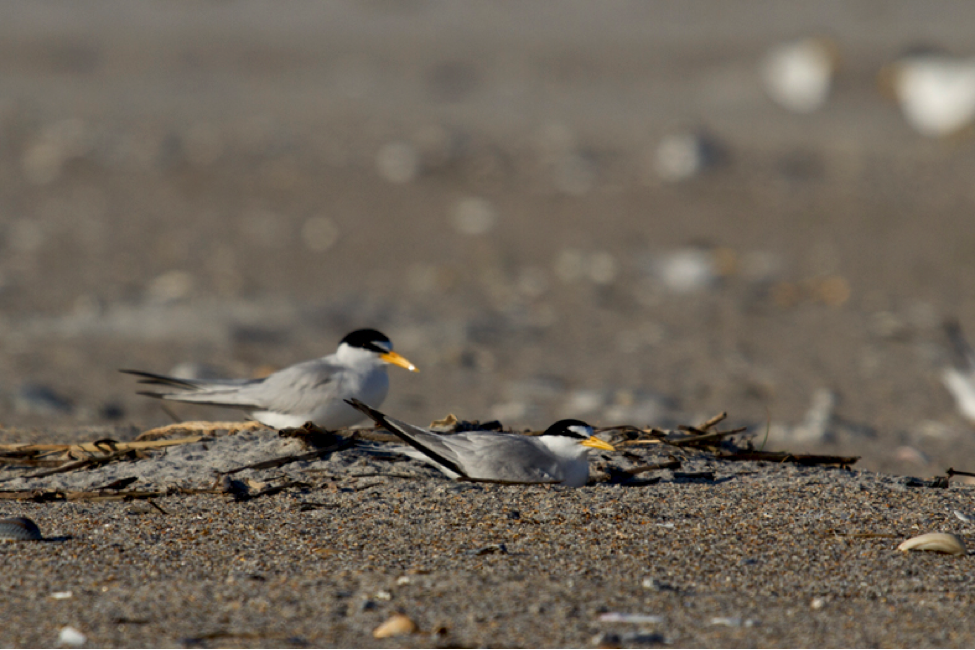Every year, beach-nesting species like the Least Tern and Black Skimmer take on long journeys from their wintering grounds in the Caribbean and South America venturing to their nesting grounds all along the Atlantic seaboard. They will continue the voyage until they finally find a suitable place to nest, a location which must be both near a food source and undisturbed by humans.
Audubon's bird sanctuary at the south end of Wrightsville Beach, N.C. is a favorite among many beach-nesting birds. Each summer, nesting species arrive to raise the next generation of chicks.
Who to Spot at the Beach
Since 2009, Least Terns, Black Skimmers, American Oystercatchers, Common Terns and Willets have gathered at the south end to find mates and raise their young.
Because it hosts large numbers of birds, the site serves as a significant nesting site for beach-nesting species in North Carolina. As many as 20 percent of the state’s Least Terns and Black Skimmers have nested there, and their success helps maintain healthy populations in the state and in the region.

Partnerships Help Protect Coastal Birds
In cooperation with the Town of Wrightsville Beach and Wrightsville Beach Elementary School, Audubon has implemented a program to protect this important site. This effort involves the protection of habitats and community outreach. It has grown over the years, recruiting many dedicated volunteers known as bird stewards, who both maintain the nesting site and educate beach-goers about the birds nesting there.
To prepare for the birds’ arrival in April, Audubon’s bird stewards come together to put up wooden posts, signs and nylon string—a type of symbolic fencing around the colony. Though it is not strong enough to stop a car or particularly determined beachgoer, the barrier alerts people to the presence of the colony and deters them from entering the area by explaining why the birds and habitat are protected.
Signs on the postings are adorned with the art of local Wrightsville Beach Elementary School 5th graders, highlighting the town’s dedication to protecting the birds.
What Birds Need
Wrightsville Beach’s nesting colony includes several species, all of which have specific habitat requirements for their nesting grounds. Some, like the American Oystercatcher and Common Tern, will nest on the beach in front of, on top of, or among dunes. Others like the Least Tern and Black Skimmer form large nesting colonies on flat areas of sand with sparse vegetation. The Willet is the exception in this group of species, as it weaves a nest of grass and often nests in clumps of vegetation.
Lucky for our local nesting birds, the south end offers an abundance of their preferred habitat!
To accommodate the birds’ different habitat needs, the posting includes all habitat types. As a result, it stretches along the southern tip of the island, encompassing dunes and a portion of the sandy spit habitually used by Least Terns and Black Skimmers.
Importance of Signage
Although one may wonder why the birds’ habitat has to be roped off, the answer quickly becomes clear. Unlike birds like sparrows and woodpeckers, beach-nesting birds don’t nest in trees—they actually nest right on the ground!
Rather than constructing nests of sticks and leaves, most beach-nesting species make “scrapes” in the sand which serve as their nests. Some scrapes, like those of the Common Terns and American Oystercatchers, include embellishments of shells and pieces of wrack, but a majority of nests are simple dips in the sand.
Because they nest right on the ground, beach-nesting birds’ eggs are colored and speckled just like the sand in order to protect them from sharp-eyed predators like foxes and crows. This helpful adaptation makes the eggs very hard for people to see, so it’s easy for beachgoers to accidentally step on a nest and destroy the eggs.
Simply approaching too close and scaring birds off of eggs or chicks also poses danger. Parent birds incubate their eggs and shade chicks to keep them just the right temperature, but if they are scared away by people or dogs, they can easily overheat. Dogs are especially harmful as beach-nesting birds instinctively perceive even the best-behaved dog as a natural predator and fly quickly from their nests.
Unattended eggs or chicks can fall prey to gulls and crows that are only too willing to swoop in and nab a quick meal. So it’s very important to allow beach-nesting birds to tend to their young.
The area protected by symbolic fencing is an ideal way to minimize the number of disturbances that threaten vulnerable eggs and chicks. People are still able to enjoy the beach even as the birds are protected, making for happy people and safe birds!
Join the Wrightsville Beach bird stewards at the south end this summer on Monday mornings at 9 a.m. for a free guided tour of the nesting colony. We meet at the wooden gazebo at Beach Access 43.



